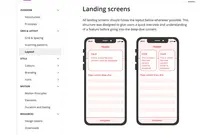The importance of accessible and inclusive design for digital health and pharma products
10 June 24
Accessible design best practices
Simplicity of design
Always consider accessibility from the start to avoid breaking a well-thought experience at the last minute. Avoiding complexity in design will make it easier for all visitors to navigate, regardless of ability. A simple and logical design is easier to use for those using assistive technologies as well as many others, for example, those with learning disabilities.
Appropriate colour contrast
With approximately 8% of the population experiencing some form of colour deficiency in sight, using colour and contrast effectively is an important consideration.
You should ensure that the contrast between text and it’s background is significant enough to be read easily. Colour should also not be relied upon to distinguish important content.
Design for screen readers
It’s important to think about how screen reading devices will interpret your website or digital product. Your HTML code should match the structure of the front-end or your website. Alt tags should be included to clearly describe images and other visual elements, and captions or transcripts should be provided for audio and video content.
Structure your content clearly
Clearly-structured content will be content that’s easier to read and understand for all users. For those using screen readers or with impaired vision, clear headings — with appropriate H1 and H2 tags — will improve readability.
The importance of user testing in ensuring design is accessible
Whilst following best practices is always a great start, testing your product with a diverse pool of users should always be your next step.
Observation and inquiry (the fundamental principles of usability testing) are the ultimate tools for understanding how people with disabilities use digital products: for example, how someone who is blind uses a touchscreen.
Testing allows you to sympathise with users and understand their pain points along the journeys you’ve designed. This exercise highlights opportunity areas to improve accessibility and user experience.
Whilst quantitative data is great to understand what users are doing, numbers on an analytics dashboard will never tell you why users aren’t managing to complete a task or get the maximum value from your product. Without usability testing, our designs will almost always create inequality in the experiences people have with our products.
By testing with users of varying accessibility requirements (e.g. visual impairment, or neurological disorder) against accessibility gold standards such as the WCAG, we can quickly uncover user needs that can be met with rapid iterations in the design process.
Something which could have easily been overlooked, like the need for dyslexic users to have clear contrast options, can be identified in the design process and packaged up for development. As a result, you can design a product or service that is more accessible to all.
You should always test until saturation of insight, meaning that nothing new comes out of your tests. We know this can be challenging — if you are short on time and budget, testing with as little as 5 to 10 users will provide you with enough data to understand how to improve your product’s accessibility.
Moderated usability testing is a great way to observe how users interact with your product whilst following up with probing questions to capture their cognitions and emotions — the ‘why’. If you’re short on time or expertise, unmoderated usability testing can provide quicker (but sometimes less detailed) insights.
Whatever the situation, we must make the effort to user test any new digital products or services before shipping to ensure they are accessible and inclusive.
Useful resources
- The A11Y Project: https://www.a11yproject.com/
- WCAG guidelines and standards: https://www.w3.org/WAI/standards-guidelines/wcag/
- WCAG mobile-specific guidelines: https://www.w3.org/WAI/standards-guidelines/mobile/
- Microsoft inclusive design guidance: https://www.microsoft.com/design/inclusive/
- US gov’t guidelines: https://accessibility.digital.gov/ux/getting-started/
We help our clients integrate user-centric design in their digital health and pharma products
We work with global healthcare and pharmaceutical organisations to achieve digital transformation, create exceptional user experiences and innovate to achieve business goals.
We put the user at the heart of everything we do — whether that be through thoughtful and insight-driven user research, or ensuring accessible and inclusive design standards are maintained.
Get in touch to find out how we can help you to optimise your digital healthcare or pharma products and services.


